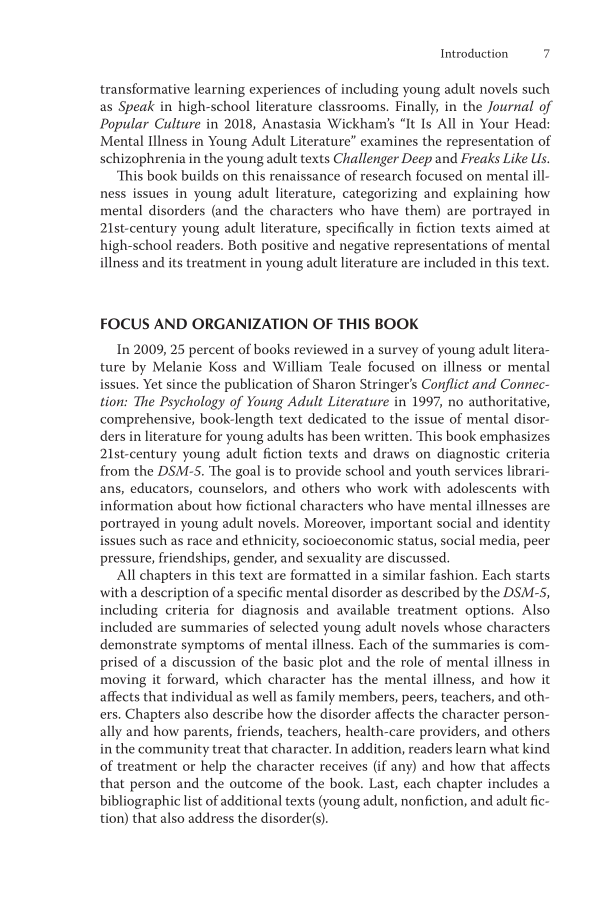Introduction 7 transformative learning experiences of including young adult novels such as Speak in high-school literature classrooms. Finally, in the Journal of Popular Culture in 2018, Anastasia Wickham’s “It Is All in Your Head: Mental Illness in Young Adult Literature” examines the representation of schizophrenia in the young adult texts Challenger Deep and Freaks Like Us. This book builds on this renaissance of research focused on mental ill- ness issues in young adult literature, categorizing and explaining how mental disorders (and the characters who have them) are portrayed in 21st-century young adult literature, specifically in fiction texts aimed at high-school readers. Both positive and negative representations of mental illness and its treatment in young adult literature are included in this text. FOCUS AND ORGANIZATION OF THIS BOOK In 2009, 25 percent of books reviewed in a survey of young adult litera- ture by Melanie Koss and William Teale focused on illness or mental issues. Yet since the publication of Sharon Stringer’s Conflict and Connec- tion: The Psychology of Young Adult Literature in 1997, no authoritative, comprehensive, book-length text dedicated to the issue of mental disor- ders in literature for young adults has been written. This book emphasizes 21st-century young adult fiction texts and draws on diagnostic criteria from the DSM-5. The goal is to provide school and youth services librari- ans, educators, counselors, and others who work with adolescents with information about how fictional characters who have mental illnesses are portrayed in young adult novels. Moreover, important social and identity issues such as race and ethnicity, socioeconomic status, social media, peer pressure, friendships, gender, and sexuality are discussed. All chapters in this text are formatted in a similar fashion. Each starts with a description of a specific mental disorder as described by the DSM-5, including criteria for diagnosis and available treatment options. Also included are summaries of selected young adult novels whose characters demonstrate symptoms of mental illness. Each of the summaries is com- prised of a discussion of the basic plot and the role of mental illness in moving it forward, which character has the mental illness, and how it affects that individual as well as family members, peers, teachers, and oth- ers. Chapters also describe how the disorder affects the character person- ally and how parents, friends, teachers, health-care providers, and others in the community treat that character. In addition, readers learn what kind of treatment or help the character receives (if any) and how that affects that person and the outcome of the book. Last, each chapter includes a bibliographic list of additional texts (young adult, nonfiction, and adult fic- tion) that also address the disorder(s).
Document Details My Account Print multiple pages
Print
You have printed 0 times in the last 24 hours.
Your print count will reset on at .
You may print 0 more time(s) before then.
You may print a maximum of 0 pages at a time.


































































































































































































































